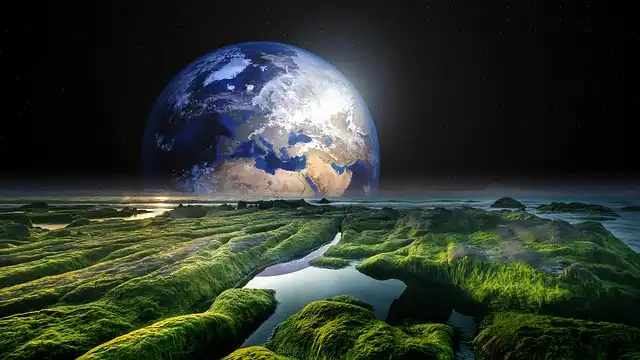Humanity’s Decline: Analyzing Our Future & Survival Strategies

Explore humanity's future decline due to environmental impact and resource depletion. The book examines our origins, current challenges, and potential survival strategies, including space colonization and urgent action.
Humanity’s Impact on the Environment
One more argument regarding our impending death originates from “termination financial obligation”: when varieties damage their environment and at some point run out of resources. We humans have actually come to be the leading species, pushing several thousands of species to extinction by changing environments for growing food, harvesting wood, dumping our waste and so on.
Gee has a classy, if highly unlikely remedy to saving our types. It could simply be feasible in the following century or so, he composes, with the enhanced pace of modern technology, to sustainably create human nests on the moon or Mars. We need first to establish a self-sustaining ecological communities that will certainly supply food, tidy air and all the sources required forever in order to make it through on far away space travels.
The Rise of Homo Sapiens
“Rise” summarises a deluge of recent details regarding our old beginnings. Our contemporary human species, Humankind, diverged from earlier human types around 300,000 years back. We lived along with a variety of various other such types right now.
In H.G. Wells’ dystopian 1895 novel The moment Equipment an unnamed Victorian scientist trips to the year 802,701. Rather than finding a flourishing, enlightened human civilisation gaining the advancing benefits of centuries of economic and intellectual growth, he locates a horror scene. Right here, gentle humans called Eloi are currently the farmed food for the troglodyte-like Morlocks.
His new book takes a calm look at humankind’s best decrease. This is something, he argues, we as a varieties can not avoid, as a result of our destructive impact on the earth’s numerous settings, a few of which are essential for our future food protection. He does use some expect our survival beyond this time-frame, however it would depend on extreme, unlikely solutions.
Secondly, the populations of early Humankind program wonderful variability, showing past populations were primarily isolated, not blending significantly. Little populations are extra prone to natural calamities, so are conveniently eliminated by floodings, tsunamis, fires, volcanic eruptions or various other neighborhood events, maintaining populace numbers small.
A Statistical Look at Extinction Timing
The timing for our varieties termination or “End ofthe world circumstance” is determined utilizing a statistical method established by Princeton astrophysicist J. Richard Gott. The approach is based upon an analytical debate that we are living in the 95% range of humanity now, so we are more than 2.5% far from either the start or end of the types. (NB, this thinking is complex, completely discussed in the book.).
Population Stability and Genetics
Genetics informs us a great deal regarding our present populace stability. Early human varieties almost went vanished before leaving Africa due to severe climatic occasions some 930,000– 813,000 years earlier, when the breeding populace diminished to an estimated 1,280 people on the whole world. Modern Homo sapiens developed later on as an outcome of interbreeding among and in between various other archaic human species such as Neanderthals and Denisovans, the latter known from old DNA protected in isolated little bones.
Despite all this, we climbed to over one billion individuals on earth by the 1800s and to 8 billion today, sustained by substantial boosts in farming and innovation. The previous supplied sufficient food to sustain bigger populaces, the latter lengthened lifespans.
The stoics state if we can’t do anything about an issue, we shouldn’t worry about it. But in this case there is a great deal we can all do. Ballot for the ideal individuals who will certainly enact modification is the initial step. This publication should be required analysis for all political leaders.
Our modern-day human varieties, Homo sapiens, diverged from earlier human types around 300,000 years ago. Early human types virtually went extinct prior to leaving Africa due to serious weather events some 930,000– 813,000 years ago, when the reproducing population reduced to an approximated 1,280 individuals on the whole earth. Modern Homo sapiens developed later on as an outcome of interbreeding among and in between other archaic human species such as Denisovans and neanderthals, the latter understood from old DNA protected in separated small bones.
While all this could seem disappointing, this publication is a strangely engrossing read, habit forming as a result of its continuum of fascinating truths regarding our species’ beginnings and unavoidable decline, and how we have actually influenced our world in many unforeseen methods. Sometimes sarcastic, Gee’s publication is greater than just a talk on our future. It might well be the supreme wake up call to action for everybody.
The book is organised into 3 components: Rise, getaway and autumn. Each information the story of our special types from its prehistoric beginnings though to our success as the leading creature on Earth, and ultimately, to our destiny in being too successful.
I didn’t understand human populations in the past were extremely small. The average age of other human types (currently all extinct) is mainly much less than 2-3 million years.
Other scenarios from the same resource, entailing far better education and learning and contraceptive gain access to, anticipate the 2100 populace at around 6.29 billion, and a decline from after that onwards, at some point causing a collapse once various other factors, such as our declining fertility rates (causing older populaces, and work lacks), begin.
To keep our populace stable, every woman on the planet needs to have 2.1 children (this number is the TFR or Total Fertility Rate). Also today several nations are dipping listed below this. China had a fertility price of 1.18 in 2022. Japan’s was 1.26 in 2022 although the overall fertility rate of all African countries in this year was 4.155. Around the world, nevertheless, fertility prices are decreasing swiftly.
The Role of Politics in Saving the Planet
Scientific research writer Henry Gee paints a much less horrific however similarly troubling picture of humanity’s future in his publication The Decline and Autumn of the Human Empire. Unlike Wells, Gee does not see the human species with the ability of enduring longer than the following 8000-12,000 years.
The option is simple. Scientific research offers us clear directions as to how to mitigate environment modification (by seriously decreasing our manufacturing of greenhouse gases triggering it); and just how to recover broken environments (by cleaning them up). National politics sadly typically obstructs of conserving the planet because of human greed taking top priority over any type of serious efforts at real progress around.
Only a small number of modern people that evolved in Africa ever before moved away from this continent, beginning around 60,000 years ago. These ultimately became our living human population of the world today. As Gee explains, “movement, is of course, the all-natural state of humanity”, a lesson with fantastic implications for exactly how we treat migrants today, most of whom are forced to flee war-torn or ecologically deteriorated areas.
In between 1450-1750 there were 73 Hapsburg marital relationships, several in between close to relations. This is plainly not excellent for the species.
Declining Fertility Rates: A Global Concern
We human beings stand for a brand-new force of development altering the biomass and reshaping most of our terrestrial ecological communities. We are likewise altering numerous marine ones, because of enhanced pollution, massive, over-fishing and the impacts of commercial delivery routes.
The decline in our ability to duplicate as efficiently as in past populations is one more fear for our types. The loss of the Y Chromosome in guys, which is degenerating quickly, is a troubling pattern, (though it might be dealt with via genetic modern technology in the future). However, in some nations, male sperm counts and sperm top quality are declining at an alarming rate.
The ordinary age of various other human types (now all extinct) is mainly much less than 2-3 million years. Our types has only been around regarding 300,000 years. If we are nearer the end of our species than the beginning, (thinking numerous aspects leading to environmental collapse would certainly occur quicker instead than later on), Gee states,.
Random illness or pandemics can, certainly, strike populations without caution. Numerous advanced because of the development of agriculture, when humans and pets came into closer call. Viruses like influenza, TB and plague are some examples of animal-borne diseases that leapt to people, precisely as COVID performed in 2020, however because case not from a tamed source.
This big terrarium (1.27 hectares) had 3000 species of plants and animals, with 8 humans living inside its enclosed walls. The experiment lasted under 3 years before the humans inside had to break the seal to let fresh air in.
Every one of this pleads the inquiry what can we do currently? The answer is not regarding conserving our types for life (all types have a limited life-span). It’s issue of how much time do we have?. We can prolong our species chances of longer survival if we can conserve our world from more destruction and imminent environmental collapse, but we must we act now to do so.
I found this area filled with interesting new point of views. For instance, I really did not know human populaces in the past were really tiny. Fossil human remains are unbelievably uncommon in the majority of websites, full of lots of various other type of creatures or bird continues to be.
The initial detailed account of this, by Danish gynaecologist and obstetrician Elisabeth Carlesen and her team, revealed sperm counts cut in half in between 1940 and 1990. In Nigeria, sperm count and top quality has actually come by 72.6% over the previous 50 years.
1 climate change2 environmental collapse
3 future survival
4 human extinction
5 population decline
6 space colonization
« YA Book Prize 2025: Judging Panel AnnouncedPeter Lovesey: Crime Writing Legend Remembered »
